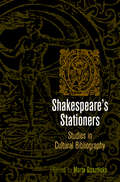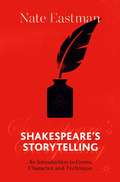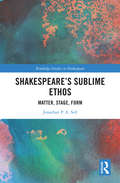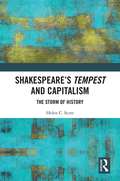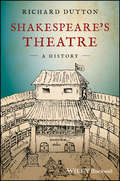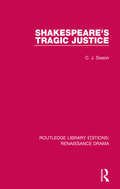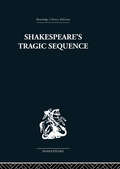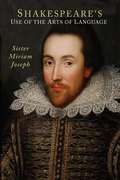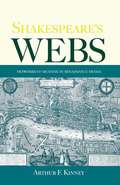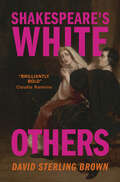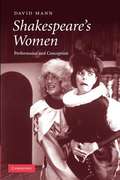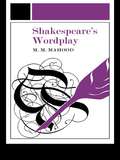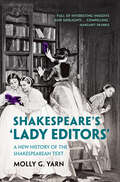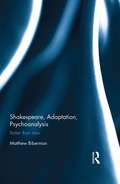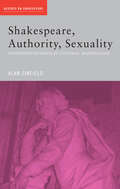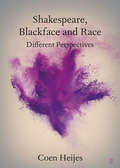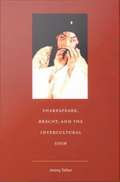- Table View
- List View
Shakespeare's Stage Traffic
by Janet ClareShakespeare's unique status has made critics reluctant to acknowledge the extent to which some of his plays are the outcome of adaptation. In Shakespeare's Stage Traffic Janet Clare re-situates Shakespeare's dramaturgy within the flourishing and competitive theatrical trade of the late sixteenth and early seventeenth centuries. She demonstrates how Shakespeare worked with materials which had already entered the dramatic tradition, and how, in the spirit of Renaissance theory, he moulded and converted them to his own use. The book challenges the critical stance that views the Shakespeare canon as essentially self-contained, moves beyond the limitations of generic studies and argues for a more conjoined critical study of early modern plays. Each chapter focuses on specific plays and examines the networks of influence, exchange and competition which characterised stage traffic between playwrights, including Marlowe, Jonson and Fletcher. Overall, the book addresses multiple perspectives relating to authorship and text, performance and reception.
Shakespeare's Stationers: Studies in Cultural Bibliography (Material Texts)
by Marta StraznickyRecent studies in early modern cultural bibliography have put forth a radically new Shakespeare—a man of keen literary ambition who wrote for page as well as stage. His work thus comes to be viewed as textual property and a material object not only seen theatrically but also bought, read, collected, annotated, copied, and otherwise passed through human hands. This Shakespeare was invented in large part by the stationers—publishers, printers, and booksellers—who produced and distributed his texts in the form of books. Yet Shakespeare's stationers have not received sustained critical attention.Edited by Marta Straznicky, Shakespeare's Stationers: Studies in Cultural Bibliography shifts Shakespearean textual scholarship toward a new focus on the earliest publishers and booksellers of Shakespeare's texts. This seminal collection is the first to explore the multiple and intersecting forms of agency exercised by Shakespeare's stationers in the design, production, marketing, and dissemination of his printed works. Nine critical studies examine the ways in which commerce intersected with culture and how individual stationers engaged in a range of cultural functions and political movements through their business practices. Two appendices, cataloguing the imprints of Shakespeare's texts to 1640 and providing forty additional stationer profiles, extend the volume's reach well beyond the case studies, offering a foundation for further research.
Shakespeare's Storytelling: An Introduction to Genre, Character, and Technique
by Nate EastmanShakespeare’s Storytelling: An Introduction to Genre, Character, and Technique is a textbook focused on specific storytelling techniques and genres that Shakespeare invented or refined. Drawing on examples from popular novels, plays, and films (such as IT, Beloved, Sex and the City, The Godfather, and Fences) the book provides an overview of how Shakespearean storytelling techniques including character flaws, conflicts, symbols, and more have been adapted by later writers and used in the modern canon. Rather than taking a historicist or theoretical approach, Nate Eastman uses recognizable references and engaging language to teach the concepts and techniques most applicable to the future study of Creative Writing, English, Theater, and Film and Media. Students will be prepared to interpret Shakespeare’s plays and understand Shakespeare as the beginning of a literary tradition. A readable introduction to Shakespeare and his significance, this book is suitable for undergraduates.
Shakespeare's Sublime Ethos: Matter, Stage, Form (Routledge Studies in Shakespeare)
by Jonathan P. SellShakespeare’s Sublime Ethos: Matter, Stage, Form breaks new ground in providing a sustained, demystifying treatment of its subject and looking for answers to basic questions regarding the creation, experience, aesthetics and philosophy of Shakespearean sublimity. More specifically, it explores how Shakespeare generates a sublime mood or ethos which predisposes audiences intellectually and emotionally for the full experience of sublime pathos, explored in the companion volume, Shakespeare’s Sublime Pathos. To do so, it examines Shakespeare’s invention of sublime matter, his exploitation of the special characteristics of the Elizabethan stage, and his dramaturgical and formal simulacra of absolute space and time. In the process, it considers Shakespeare’s conception of the universe and man’s place in it and uncovers the epistemological and existential implications of key aspects of his art. As the argument unfolds, a case is made for a transhistorically baroque Shakespeare whose "bastard art" enables the dramatic restoration of an original innocence where ignorance really is bliss. Taken together, Shakespeare’s Sublime Ethos and Shakespeare’s Sublime Pathos show how Shakespearean drama integrates matter and spirit on hierarchical planes of cognition and argue that, ultimately, his is an immanent sublimity of the here-and-now enfolding a transcendence which may be imagined, simulated or evoked, but never achieved.
Shakespeare's Sublime Pathos: Person, Audience, Language (Routledge Studies in Shakespeare)
by Jonathan P. SellShakespeare’s Sublime Pathos: Person, Audience, Language breaks new ground in providing a sustained, demystifying treatment of its subject and looking for answers to basic questions regarding the creation, experience, aesthetics and philosophy of Shakespearean sublimity. More specifically, it explores how Shakespeare generates experiences of sublime pathos, for which audiences have been prepared by the sublime ethos described in the companion volume, Shakespeare’s Sublime Ethos. To do so, it examines Shakespeare’s model of mutualistic character, in which "entangled" language brokers a psychic communion between fictive persons and real-life audiences and readers. In the process, Sublime Critical platitudes regarding Shakespeare’s liberating ambiguity and invention of the human are challenged, while the sympathetic imagination is reinstated as the linchpin of the playwright’s sublime effects. As the argument develops, the Shakespearean sublime emerges as an emotional state of vulnerable exhilaration leading to an ethically uplifting openness towards others and an epistemologically bracing awareness of human unknowability. Taken together, Shakespeare’s Sublime Pathos and Shakespeare’s Sublime Ethos show how Shakespearean drama integrates matter and spirit on hierarchical planes of cognition and argue that, ultimately, his is an immanent sublimity of the here-and-now enfolding a transcendence which may be imagined, simulated or evoked, but never achieved.
Shakespeare's Tempest and Capitalism: The Storm of History
by Helen C. ScottIn this forceful study, Helen C. Scott situates The Tempest within Marxist analyses of the ‘primitive accumulation’ of capital, which she suggests help explain the play’s continued and particular resonance. The ‘storm’ of the title refers both to Shakespeare’s Tempest hurtling through time, and to Walter Benjamin’s concept of history as a succession of violent catastrophes. Scott begins with an account of the global processes of dispossession—of the peasantry and indigenous populations—accompanying the emergence of capitalism, which generated new class relationships, new understandings of human subjectivity, and new forms of oppression around race, gender, and disability. Developing a detailed reading of the play at its moment of production in the business of theatre in 1611, Scott then moves gracefully through the global reception history, showing how its central thematic concerns and figurative patterns bespeak the upheavals and dispossessions of successive stages of capitalist development. Paying particular attention to moments of social crisis, and unearthing a radical political tradition, Scott follows the play from its hostile takeover in the Restoration, through its revival by the Romantics, and consolidation and contestation in the nineteenth century. In the twentieth century transatlantic modernism generated an acutely dystopic Tempest, then during the global transformations of the 1960s postcolonial writers permanently associated it with decolonization. At century’s end the play became a vehicle for exploring intersectional oppression, and the remarkable ‘Sycorax school’ featured iconoclastic readings by writers such as Abena Busia, May Joseph, and Sylvia Wynter. Turning to both popular culture and high-profile stage productions in the twenty-first century, Scott explores the ramifications and figurative potential of Shakespeare's Tempest for global social and ecological crises today. Sensitive to the play’s original concerns and informed by recent scholarship on performance and reception history as well as disability studies, Scott’s moving analysis impels readers towards a fresh understanding of sea-change and metamorphosis as potent symbols for the literal and figurative tempests of capitalism’s old age now threatening ‘the great globe itself.’
Shakespeare's Theatre: A History
by Richard DuttonShakespeare’s Theatre: A History examines the theatre spaces used by William Shakespeare, and explores these spaces in relation to the social and political framework of the Elizabethan era. The text journeys from the performing spaces of the provincial inns, guild halls and houses of the gentry of the Bard’s early career, to the purpose-built outdoor playhouses of London, including the Globe, the Theatre, and the Curtain, and the royal courts of Elizabeth and James I. The author also discusses the players for whom Shakespeare wrote, and the positioning—or dispositioning—of audience members in relation to the stage. Widely and deeply researched, this fascinating volume is the first to draw on the most recent archaeological work on the remains of the Rose and the Globe, as well as continuing publications from the Records of Early English Drama project. The book also explores the contentious view that the ‘plot’ of The Seven Deadly Sins (part II), provides unprecedented insight into the working practices of Shakespeare’s company and includes a complete and modernized version of the ‘plot’. Throughout, the author relates the practicalities of early modern playing to the evolving systems of aristocratic patronage and royal licensing within which they developed Insightful and engaging, Shakespeare’s Theatre is ideal reading for undergraduates, postgraduates, and scholars of literature and theatre studies.
Shakespeare's Tragedies
by G B HarrisonFirst published in 1951. G B Harrison here recognizes that Shakespeare's tragedies were intended for performance in a theatre and that the playwright's conspicuous gift among his contemporaries was a sympathy for joy and sorrow, pity and terror, and right and wrong of his people. The plays covered are: Titus Andronicus, Romeo and Juliet, Julius Caesar, Hamlet, Troilus and Cressida, Othello, King Lear, Macbeth, Antony and Cleopatra, Coriolanus and Timon of Athens.
Shakespeare's Tragedies: All That Matters (All That Matters)
by Michael ScottIn Shakespeare's Tragedies: All That Matters, Michael Scott explores and explains the secrets that have made Shakespeare's tragedies so enduring that they continue to be performed, watched and studied by millions of people every year. Professor Scott concentrates on the four great tragedies - Hamlet, King Lear, Othello and Macbeth - and builds an argument based around Shakespeare's use of language to prompt the audience's imagination and thought. This original little book, and its companion volume, Shakespeare's Comedies, will help you understand each of the plays in the context of its oeuvre and the changing concept of Shakespearean tragedy across the centuries.Appealing to both students and general readers, this book gives a fascinating introduction to Shakespeare's tragedies - and what matters most about them.
Shakespeare's Tragic Justice (Routledge Library Editions: Renaissance Drama)
by C. J. SissonThe problem of justice seems to have haunted Shakespeare as it haunted Renaissance Christendom. In this book, first published in 1963, four aspects of the problems of justice in action in Shakespeare’s great tragedies are explored. This study is based on the lifetime’s research of Elizabethan habits of mind by one of the most distinguished Shakespearean scholars, and will be of interest to students of English Literature, Drama and Performance.
Shakespeare's Tragic Sequence
by Kenneth MuirFirst published in 1972. The emphasis of this book is that each of Shakespeare's tragedies demanded its own individual form and that although certain themes run through most of the tragedies, nearly all critics refrain from the attempt to apply external rules to them. The plays are almost always concerned with one person; they end with the death of the hero; the suffering and calamity that befall him are exceptional; and the tragedies include the medieval idea of the reversal of fortune.
Shakespeare's Tragic Skepticism
by Millicent BellShakespeare's Tragic Skepticism has an ambitious aim. In writing it, I have tried to mark out a pathway across a trampled field, discussing plays more commented on over four centuries than anything else ever written except the Hebraic-Christian Bible.
Shakespeare's Use of the Arts of Language
by Sister Miriam JosephThis was the first book which presented, in a complete manner, a general theory of composition then current in Renaissance England. Its particular contribution is the reorganization of the two hundred figures of speech, distinguished by Renaissance rhetoricians, into a simple, understandable pattern basic in Aristotle's Rhetoric: grammar logos, pathos and ethos. The purpose of the book is to provide a handbook of the theory of composition then current during the English Renaissance and to show Shakespeare's use of this theory by simple illustration from his plays and poems. The book is addressed to the wide audience of teachers of English and Renaissance literature, the philologist, the Shakespearian scholar, and to students and teachers of all Romance languages.
Shakespeare's Webs: Networks of Meaning in Renaissance Drama
by Arthur F. KinneyIn this book, renowned Renaissance drama critic Arthur F. Kinney argues that Shakespeare's method of composing plays through networks of meanings can be seen as a harbinger of today's information technology. Drawing upon hypertext and cognitive theory--areas that have for some time promised to take on more importance in the sphere of Shakespeare Studies--as well as the central metaphor of the Routledge collection The Renaissance Computer, Kinney looks in detail at four objects/images in Shakespeare's plays--mirrors, maps, clocks, and books--and explores the ways in which they make up networks of meaning within single plays and across the dramatist's body of work that anticipate in some ways the networks of meaning or "information" now possible in the computer age.
Shakespeare's White Others
by David Sterling BrownExamining the racially white 'others' whom Shakespeare creates in characters like Richard III, Hamlet and Tamora – figures who are never quite 'white enough' – this bold and compelling work emphasises how such classification perpetuates anti-Blackness and re-affirms white supremacy. David Sterling Brown offers nothing less here than a wholesale deconstruction of whiteness in Shakespeare's plays, arguing that the 'white other' was a racialized category already in formation during the Elizabethan era – and also one to which Shakespeare was himself a crucial contributor. In exploring Shakespeare's determinative role and strategic investment in identity politics (while drawing powerfully on his own life experiences, including adolescence), the author argues that even as Shakespearean theatrical texts functioned as engines of white identity formation, they expose the illusion of white racial solidarity. This essential contribution to Shakespeare studies, critical whiteness studies and critical race studies is an authoritative, urgent dismantling of dramatized racial profiling.
Shakespeare's Women: Performance and Conception
by David MannDavid Mann examines the influence of the Elizabethan cross-dressed tradition on the performance and conception of Shakespeare's female roles through an analysis of all 205 extant plays written for the adult theater. The study provides both an historical context, showing how performance practice developed in the era before Shakespeare, and a comparative one, in revealing how dramatists in general treated their female characters and the influence their characterization had upon Shakespeare's writing. The book challenges many views of the sexual ethos of Elizabethan theater, offering instead a picture of Shakespeare which pays less attention to his supposed gender politics and more to his ability to exploit the cross-dressed convention as a dramatic medium. By challenging the gay and polemical feminist accounts that currently dominate the treatment of Elizabethan cross-dressing, the book restores its importance as a mainstream performance topic for academics and students.
Shakespeare's Wordplay
by M. M. Mahood`Professor Mahood's book has established itself as a classic in the field, not so much because of the ingenuity with which she reads Shakespeare's quibbles, but because her elucidation of pun and wordplay is intelligently related both to textual
Shakespeare's Words: A Glossary and Language Companion (Canto Classics Ser.)
by David Crystal Ben CrystalA vital resource for scholars, students and actors, this book contains glosses and quotes for over 14,000 words that could be misunderstood by or are unknown to a modern audience. Displayed panels look at such areas of Shakespeare's language as greetings, swear-words and terms of address. Plot summaries are included for all Shakespeare's plays and on the facing page is a unique diagramatic representation of the relationships within each play.
Shakespeare's ‘Lady Editors': A New History of the Shakespearean Text
by Molly G. YarnThe basic history of the Shakespearean editorial tradition is familiar and well-established. For nearly three centuries, men – most of them white and financially privileged – ensconced themselves in private and hard-to-access libraries, hammering out 'their' versions of Shakespeare's text. They produced enormous, learnèd tomes: monuments to their author's greatness and their own reputations. What if this is not the whole story? A bold, revisionist and alternative version of Shakespearean editorial history, this book recovers the lives and labours of almost seventy women editors. It challenges the received wisdom that, when it came to Shakespeare, the editorial profession was entirely male-dominated until the late twentieth century. In doing so, it demonstrates that taking these women's work seriously can transform our understanding of the history of editing, of the nature of editing as an enterprise, and of how we read Shakespeare in history.
Shakespeare, Adaptation, Psychoanalysis: Better than New
by Matthew BibermanIn Shakespeare, Adaptation, Psychoanalysis, Matthew Biberman analyzes early adaptations of Shakespeare’s plays in order to identify and illustrate how both social mores and basic human psychology have changed in Anglo-American culture. Biberman contests the received wisdom that Shakespeare’s characters reflect essentially timeless truths about human nature. To the contrary, he points out that Shakespeare’s characters sometimes act and think in ways that have become either stigmatized or simply outmoded. Through his study of the adaptations, Biberman pinpoints aspects of Shakespeare’s thinking about behavior and psychology that no longer ring true because circumstances have changed so dramatically between his time and the time of the adaptation. He shows how the adaptors’ changes reveal key differences between Shakespeare’s culture and the culture that then supplanted it. These changes, once grasped, reveal retroactively some of the ways in which Shakespeare’s characters do not act and think as we might expect them to act and think. Thus Biberman counters Harold Bloom’s claim that Shakespeare fundamentally invents our sense of the human; rather, he argues, our sense of the human is equally bound up in the many ways that modern culture has come to resist or outright reject the behavior we see in Shakespeare’s plays. Ultimately, our current sense of 'the human' is bound up not with the adoption of Shakespeare’s psychology, perhaps, but its adaption-or, in psychoanalytic terms, its repression and replacement.
Shakespeare, Alchemy and the Creative Imagination
by Margaret HealyShakespeare's Sonnets and A Lover's Complaint constitute a rich tapestry of rhetorical play about Renaissance love in all its guises. A significant strand of this is spiritual alchemy: working the 'metal' of the mind through meditation on love, memory work and intense imagination. Healy demonstrates how this process of anguished soul work - construed as essential to inspired poetic making - is woven into these poems, accounting for their most enigmatic imagery and urgency of tone. The esoteric philosophy of late Renaissance Neoplatonic alchemy, which embraced bawdy sexual symbolism and was highly fashionable in European intellectual circles, facilitated Shakespeare's inscription of an interior drama of a desiring mind creating poetry. Arguing that Shakespeare's incorporation of alchemical textures throughout his late works is indicative of an artistic stance promoting religious toleration and unity, this book sets out a crucial new framework for interpreting the 1609 poems, and transforms our understanding of Shakespeare's art.
Shakespeare, Aphra Behn and the Canon (Approaching Literature #Bk. 3)
by Lizbeth Goodman W.R. OwensA clear introduction to the idea of the canon, exploring the process by which certain works, and not others, receive high cultural status. The work of Shakespeare and Aphra Behn is used to illustrate and challenge this process.
Shakespeare, Authority, Sexuality: Unfinished Business in Cultural Materialism (Accents on Shakespeare)
by Alan SinfieldShakespeare, Authority, Sexuality is a powerful reassessment of cultural materialism as a way of understanding textuality, history and culture, by one of the founding figures of this critical movement. Alan Sinfield examines cultural materialism both as a body of ongoing argument and as it informs particular works by Shakespeare and his contemporaries, especially in relation to sexuality in early-modern England and queer theory. The book has several interlocking preoccupations: theories of textuality and reading the political location of Shakespearean plays and the organisation of literary culture today the operation of state power in the early-modern period and the scope for dissidence the sex/gender system in that period and the application of queer theory in history. These preoccupations are explored in and around a range of works by Shakespeare and his contemporaries. Throughout the book Sinfield re-presents cultural materialism, framing it not as a set of propositions, as has often been done, but as a cluster of unresolved problems. His brilliant, lucid and committed readings demonstrate that the ‘unfinished business’ of cultural materialism - and Sinfield’s work in particular - will long continue to produce new questions and challenges for the fields of Shakespeare and Renaissance Studies.
Shakespeare, Blackface and Race: Different Perspectives (Elements in Shakespeare Performance)
by Coen HeijesThis Element addresses the topical debate on blackface, race and Othello. With Shakespeare performance studies being rather Anglo-centric, the author explores how this debate has taken a radically different course in the Netherlands, a country historically perceived as tolerant and culturally close to the UK. Through several case studies, including the Van Hove Othello of 2003/2012 and the latest, controversial 2018/2020 Othello, the first main house production with a black actor as Othello, the author analyses the interaction between blackface and (institutional) racism in Dutch society and theatre and how Othello has become an active player in this debate.
Shakespeare, Brecht, and the Intercultural Sign
by Antony TatlowIn Shakespeare, Brecht, and the Intercultural Sign renowned Brecht scholar Antony Tatlow uses drama to investigate cultural crossings and to show how intercultural readings or performances question the settled assumptions we bring to interpretations of familiar texts. Through a "textual anthropology" Tatlow examines the interplay between interpretations of Shakespeare and readings of Brecht, whose work he rereads in the light of theories of the social subject from Nietzsche to Derrida and in relation to East Asian culture, as well as practices within Chinese and Japanese theater that shape their versions of Shakespearean drama. Reflecting on how, why, and to what effect knowledges and styles of performance pollinate across cultures, Tatlow demonstrates that the employment of one culture's material in the context of another defamiliarizes the conventions of representation in an act that facilitates access to what previously had been culturally repressed. By reading the intercultural, Tatlow shows, we are able not only to historicize the effects of those repressions that create a social unconscious but also gain access to what might otherwise have remained invisible. This remarkable study will interest students of cultural interaction and aesthetics, as well as readers interested in theater, Shakespeare, Brecht, China, and Japan.

